City in Arkhangelsk Oblast, Russia
| Arkhangelsk Архангельск | |
|---|---|
| City | |
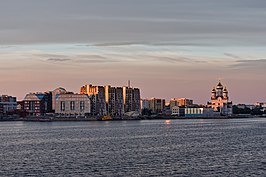    Top-down, left-to-right: View along the Northern Dvina river; Port of Arkhangelsk; Church of the Dormition and sea beach; view to the skyscraper Vysotka Top-down, left-to-right: View along the Northern Dvina river; Port of Arkhangelsk; Church of the Dormition and sea beach; view to the skyscraper Vysotka | |
 Coat of arms Coat of arms | |
| Location of Arkhangelsk | |
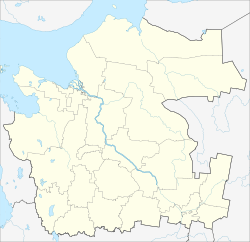   | |
| Coordinates: 64°32′35″N 40°32′15″E / 64.54306°N 40.53750°E / 64.54306; 40.53750 | |
| Country | Russia |
| Federal subject | Arkhangelsk Oblast |
| Novo-Kholmogory | 1584 |
| City status since | 1584 |
| Government | |
| • Body | City Duma |
| • Head | Dmitry Morev |
| Area | |
| • Total | 294.42 km (113.68 sq mi) |
| Elevation | 3 m (10 ft) |
| Population | |
| • Total | 348,783 |
| • Estimate | 349,742 (+0.3%) |
| • Rank | 50th in 2010 |
| • Density | 1,185/km (3,070/sq mi) |
| Administrative status | |
| • Subordinated to | city of oblast significance of Arkhangelsk |
| • Capital of | Arkhangelsk Oblast, city of oblast significance of Arkhangelsk |
| Municipal status | |
| • Urban okrug | Arkhangelsk Urban Okrug |
| • Capital of | Arkhangelsk Urban Okrug, Primorsky Municipal District |
| Time zone | UTC+3 (MSK |
| Postal code(s) | 163000-163071 |
| Dialing code(s) | +7 8182 |
| OKTMO ID | 11701000001 |
| City Day | Last Sunday of June |
| Website | www |
Arkhangelsk (Russian: Архангельск, pronounced [ɐrˈxanɡʲɪlʲsk]) is a city and the administrative center of Arkhangelsk Oblast, Russia. It lies on both banks of the Northern Dvina near its mouth into the White Sea. The city spreads for over 40 kilometres (25 mi) along the banks of the river and numerous islands of its delta. Arkhangelsk was the chief seaport of medieval and early modern Russia until 1703, when it was replaced by the newly founded Saint Petersburg.
A 1,133-kilometer-long (704 mi) railway runs from Arkhangelsk to Moscow via Vologda and Yaroslavl, and air travel is served by the Talagi Airport and the smaller Vaskovo Airport. As of the 2021 Census, the city's population was 301,199.
Coat of arms
The arms of the city display the Archangel Michael in the act of defeating the Devil. Legend states that this victory took place near where the city stands, hence its name, and that Michael still stands watch over the city to prevent the Devil's return.
History
| This section needs additional citations for verification. Please help improve this article by adding citations to reliable sources in this section. Unsourced material may be challenged and removed. Find sources: "Arkhangelsk" – news · newspapers · books · scholar · JSTOR (February 2024) (Learn how and when to remove this message) |
Early history
Vikings knew the area around Arkhangelsk as Bjarmaland. Ohthere of Hålogaland told circa 890 of his travels in an area by a river and the White Sea with many buildings. This was probably the place later known as Arkhangelsk. According to Snorri Sturluson, Vikings led by Thorir Hund raided this area in 1027.
In 1989, an unusually impressive silver treasure was found by local farm workers by the mouth of Dvina, right next to present-day Arkhangelsk.
Most of the findings comprised a total of 1.6 kilograms (3.5 lb) of silver, largely in the form of coins. Jewelry and pieces of jewelry come from Russia or neighboring areas. The majority of the coins were German, but the hoard also included a smaller number of Kufan, English, Bohemian, Hungarian, Danish, Swedish and Norwegian coins. It is hard to place this find historically until further research is completed. There are at least two possible interpretations. It may be a treasure belonging to the society outlined by the Norse source material. Generally such finds, whether from Scandinavia, the Baltic area, or Russia, are closely tied to well-established agricultural societies with considerable trade activity.
Alternatively, like the Russian scientists who published the find in 1992, one may see it as evidence of a stronger case of Russian colonization than previously thought.
Novgorodian arrival
In the 12th century, the Novgorodians established a monastery dedicated to Archangel Michael in the estuary of the Northern Dvina. The main trade center of the area at that time was Kholmogory, located 75 kilometers (47 mi) southeast of Arkhangelsk, up the Dvina River, about 10 kilometers (6.2 mi) downstream from where the Pinega River flows into the Dvina. Written sources indicate that Kholmogory existed early in the 12th century, but there is no archeological material of this period. It is not known whether the origin of this settlement was Russian, or if it goes back to pre-Russian times. In the center of the small town (or Gorodok) that is there today is a large mound of building remains and river sand, but it has not been archeologically excavated.
Norwegian–Russian conflict
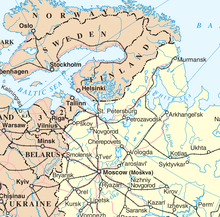
The area of Arkhangelsk came to be important in the rivalry between Norwegian and Russian interests in the northern areas. From Novgorod, the spectrum of Russian interest was extended far north to the Kola Peninsula in the 12th century. However, here Norway enforced taxes and rights to the fur trade. A compromise agreement entered in 1251 which was soon broken.
In 1411, Yakov Stepanovich from Novgorod went to attack northern Norway. This was the beginning of a series of clashes. In 1419, Norwegian ships with five hundred soldiers entered the White Sea. The "Murmaners", as the Norwegians were called (cf. Murmansk), plundered many Russian settlements along the coast, among them the Archangel Michael Monastery.
Novgorod managed to drive the Norwegians back. However, in 1478 the area was taken over by Ivan III and passed to the Grand Duchy of Moscow with the rest of the Novgorod Republic.
Trade with England, Scotland, and the Netherlands
Three English ships the Bona Esperanza, Edward Bonaventure, and Bona Confidentia set out to find the Northeast passage to China in 1553; two disappeared, and one, the Edward Bonaventure ended up in the White Sea at Nyonoksa, eventually coming across the area of Arkhangelsk at the mouth of the Dvina River where the St. Nicolas Monastery stood. Subsequently, the English gave the name St. Nicolas Bay to the sea now known as the White Sea. Ivan the Terrible found out about this, and brokered a trade agreement with the ship's captain, Richard Chancellor.
Trade privileges were granted to English merchants in 1555, leading to the founding of the Company of Merchant Adventurers, which began sending ships annually into the estuary of the Northern Dvina. Dutch merchants also started bringing their ships into the White Sea from the 1560s. Scottish and English merchants also traded in the 16th century; however, by the 17th century it was mainly the Dutch that sailed to the White Sea area.
Founding and further development
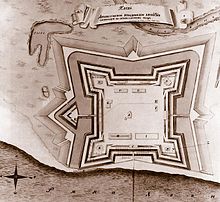
In 1584, Ivan ordered the founding of New Kholmogory (which would later be renamed after the nearby Archangel Michael Monastery). At the time access to the Baltic Sea was still mostly controlled by Sweden, so while Arkhangelsk was icebound in winter, it remained Moscow's almost sole link to the sea-trade. Local inhabitants, called Pomors, were the first to explore trade routes to Northern Siberia as far as the trans-Urals city of Mangazeya and beyond. In December 1613, during the Time of Troubles, Arkhangelsk was besieged by Polish-Lithuanian marauders commanded by Stanislaw Jasinski (Lisowczyks), who failed to capture the fortified town. In 1619, and again in 1637, fires broke out, and the entire city burned down.
In 1693, Peter the Great ordered the creation of a state shipyard in Arkhangelsk. A year later the ships Svyatoye Prorochestvo (Holy Prophecy), Apostol Pavel (Apostle Paul), and the yacht Svyatoy Pyotr (Saint Peter) were sailing in the White Sea. However, he also realized that Arkhangelsk would always be limited as a port due to the five months of ice cover, and after a successful campaign against Swedish armies in the Baltic area, he founded Saint Petersburg in May 1703. Nonetheless, Arkhangelsk continued to be an important naval base and maritime centre in the Russian north.

In 1722, Peter the Great decreed that Arkhangelsk should no longer accept goods that amounted to more than was sufficient for the town (for so-called domestic consumption). It was due to the Tsar's will to shift all international marine trade to Saint Petersburg. This factor greatly contributed to the deterioration of Arkhangelsk that continued up to 1762 when this decree was cancelled.
Arkhangelsk declined in the 18th century as the Baltic trade became ever more important. Its economy revived at the end of the 19th century when a railway to Moscow was completed and timber became a major export. The city resisted Bolshevik rule from 1918 to 1920 and was a stronghold of the anti-Bolshevik White Army. The White Army was supported by an Allied intervention in which British, French, Italian, and American troops helped to defend against the Bolsheviks. The Allied forces, led by British Lieutenant General Frederick Poole, suffered numerous set-backs and eventually withdrew from Russia. Without Allied support, the poorly disciplined White Army quickly collapsed and the Bolsheviks entered Arkhangelsk on February 21, 1920. Arkhangelsk was also the scene of the Mudyug concentration camp.
During both world wars, Arkhangelsk was a major port of entry for Allied aid. During World War II, the city became known in West Europe as one of the two main destinations (along with Murmansk) of the Arctic convoys bringing supplies in to assist the Soviet Union. During Operation Barbarossa, the German invasion of the Soviet Union in 1941, Arkhangelsk was one of two cities (the other being Astrakhan) selected to mark the envisioned eastern limit of German control. This military operation was to be halted at this A-A line, but never reached it, as the German armies failed to capture either of these two cities and also failed to capture Moscow.
Arkhangelsk was also the site of Arkhangelsk ITL, or the Arkhangelsk Labour Camp, in the 1930s and 1940s.
Today, Arkhangelsk remains a major seaport, now open year-round due to improvements in icebreakers. The city is primarily a center for the timber and fishing industries.
On March 16, 2004, 58 people were killed in an explosion at an apartment building in the city.
Administrative and municipal status
Arkhangelsk is the administrative center of the oblast and, within the framework of administrative divisions, it also serves as the administrative center of Primorsky District, even though it is not a part of it. As an administrative division, it is, together with five rural localities, incorporated separately as the city of oblast significance of Arkhangelsk—an administrative unit with the status equal to that of the districts. As a municipal division, the city of oblast significance of Arkhangelsk is incorporated as Arkhangelsk Urban Okrug.
City divisions
For administrative purposes, the city is divided into nine territorial okrugs:
- Isakogorsky
- Lomonosovsky
- Maymaksansky
- Mayskaya Gorka
- Oktyabrsky
- Severny
- Solombalsky
- Tsiglomensky
- Varavino-Faktoriya
Economy and infrastructure
Economy
Transportation
Arkhangelsk is the final destination of Northern Railway. In addition, the city is host to two airports, Vaskovo Airport and Talagi Airport where they host the 2nd Arkhangelsk United Aviation Division and Smartavia Airline, respectively. M8 highway provides a direct link to Moscow, Yaroslavl and Severodvinsk, the administrative center of the oblast. Local public transit is provided by buses and minibuses called marshrutkas. Until 2004 there were also trams, and until 2008, trolleybuses [ru].
-
 Port of Arkhangelsk
Port of Arkhangelsk
-
Port of Arkhangelsk
-
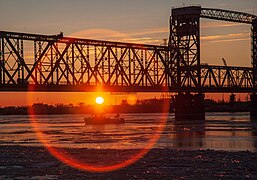 Severodvinsky bridge over Northern Dvina Canal
Severodvinsky bridge over Northern Dvina Canal
-
 Arkhangelsk train station
Arkhangelsk train station
-
 Talagi Airport
Talagi Airport
-
 Trolleybuses in Arkhangelsk
Trolleybuses in Arkhangelsk
Education

Arkhangelsk was home to Pomorsky State University and Arkhangelsk State Technical University which merged with several other institutions of higher learning in 2010 to form the Northern (Arctic) Federal University.
Arkhangelsk is home to the Northern State Medical University, Makarov state Maritime Academy, and a branch of the All-Russian Distance Institute of Finance and Economics.
Culture
| This section needs additional citations for verification. Please help improve this article by adding citations to reliable sources in this section. Unsourced material may be challenged and removed. Find sources: "Arkhangelsk" – news · newspapers · books · scholar · JSTOR (February 2024) (Learn how and when to remove this message) |
-
 Arkhangelsk drama theatre
Arkhangelsk drama theatre
-
 Arkhangelsk regional museum of local lore
Arkhangelsk regional museum of local lore
-
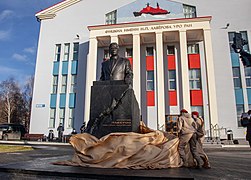 laboratory building of RAS
laboratory building of RAS
-
The Sutyagin House, claimed to be the world's tallest wooden single-family house
-
 Mir Cinema
Mir Cinema
Mikhail Lomonosov came from a Pomor village near Kholmogory. A monument to him was installed to a design by Ivan Martos in 1829. A monument to Peter the Great was designed by Mark Antokolsky in 1872 and installed in 1914.
After its historic churches were destroyed during Joseph Stalin's rule, the city's main extant landmarks are the fort-like Merchant Yards (1668–1684) and the New Dvina Fortress (1701–1705). The Assumption Church on the Dvina embankment (1742–1744) was rebuilt in 2004.
In 2008, it was decided that the city's cathedral, dedicated to the Archangel Michael, which had been destroyed under the Soviets, would be rebuilt. The foundation stone was laid in November 2008 by the regional Bishop Tikhon. The cathedral, situated near the city's main bus station and river port, is expected to be completed and consecrated in 2019.
Another remarkable structure is the Arkhangelsk TV Mast, a 151-meter (495 ft) tall guyed mast for FM-/TV-broadcasting built in 1964. This tubular steel mast has six crossbars equipped with gangways, which run in two levels from the central mast structure out to each of the three guys. On these crossbars there are also several antennas installed.
An unusual example of local "vernacular architecture" was the so-called Sutyagin House. This thirteen-story, 44-metre (144 ft) tall residence of the local entrepreneur Nikolay Petrovich Sutyagin was reported to be the world's, or at least Russia's, tallest wooden house. Constructed by Sutyagin and his family over fifteen years (starting in 1992), without plans or a building permit, the structure deteriorated while Sutyagin spent a few years in prison on racketeering charges. In 2008, it was condemned by local authorities as a fire hazard, and the courts ordered it to be demolished by February 1, 2009. On December 26, 2008, the tower was pulled down, and the remainder of the building was dismantled manually by early February 2009.

The cultural life of Arkhangelsk includes:
- The Arkhangelsk Lomonosov Drama Theater
- Arkhangelsk Philarmonia
- Arkhangelsk Youth Theater
- Arkhangelsk Oblast Museum
- Arkhangelsk Art Museum
- Stepan Pisakhov Museum
An airstrip in Arkhangelsk was the fictional setting for a level in the 1997 hit videogame Goldeneye 007.
Literature
The Russian North, and, in particular, the area of Arkhangelsk, is notable for its folklore. Until the mid-20th century, fairy tales and bylinas were still performed on the daily basis by performers who became professionals. Starting from the 1890s, folkloric expeditions have been organized to the White Sea area and later to other areas of the Arkhangelsk Governorate in order to write down the tales and the bylinas, especially in Pomor dialects.
In the 1920s, mostly due to the efforts of Anna Astakhova, these expeditions became systematic. By the 1960s, the performing art was basically extinct. These folkloric motives and fairy tales inspired the literary works of Stepan Pisakhov and Boris Shergin, who were both natives of Arkhangelsk.
Geography
Climate
Arkhangelsk experiences a subarctic climate (Köppen climate classification Dfc), with long (November–March), very cold winters and short (June–August), mildly warm summers. More extreme climates at this high latitude - such as Fairbanks, Alaska or Oymyakon, Sakha Republic - have much colder winters than Arkhangelsk, indicating that there is still significant moderation from the Atlantic Ocean.
Snowfall during winter is heavy, while summers are very rainy. Precipitation is very reliable year round.
| Climate data for Arkhangelsk (1991–2020, extremes 1881–present) | |||||||||||||
|---|---|---|---|---|---|---|---|---|---|---|---|---|---|
| Month | Jan | Feb | Mar | Apr | May | Jun | Jul | Aug | Sep | Oct | Nov | Dec | Year |
| Record high °C (°F) | 5.0 (41.0) |
5.2 (41.4) |
12.3 (54.1) |
25.3 (77.5) |
32.1 (89.8) |
33.0 (91.4) |
34.4 (93.9) |
33.4 (92.1) |
27.7 (81.9) |
18.3 (64.9) |
10.0 (50.0) |
5.8 (42.4) |
34.4 (93.9) |
| Mean daily maximum °C (°F) | −8.4 (16.9) |
−7.1 (19.2) |
−1.1 (30.0) |
5.6 (42.1) |
13.1 (55.6) |
18.7 (65.7) |
22.1 (71.8) |
18.6 (65.5) |
12.8 (55.0) |
5.0 (41.0) |
−1.9 (28.6) |
−5.3 (22.5) |
6.0 (42.8) |
| Daily mean °C (°F) | −11.6 (11.1) |
−10.7 (12.7) |
−5.5 (22.1) |
0.8 (33.4) |
7.5 (45.5) |
13.1 (55.6) |
16.5 (61.7) |
13.6 (56.5) |
8.8 (47.8) |
2.5 (36.5) |
−4.2 (24.4) |
−8.2 (17.2) |
1.9 (35.4) |
| Mean daily minimum °C (°F) | −15.2 (4.6) |
−14.4 (6.1) |
−9.7 (14.5) |
−3.4 (25.9) |
2.5 (36.5) |
7.7 (45.9) |
11.5 (52.7) |
9.3 (48.7) |
5.6 (42.1) |
0.4 (32.7) |
−6.7 (19.9) |
−11.3 (11.7) |
−2.0 (28.4) |
| Record low °C (°F) | −45.2 (−49.4) |
−41.2 (−42.2) |
−37.1 (−34.8) |
−27.3 (−17.1) |
−13.7 (7.3) |
−3.9 (25.0) |
−0.5 (31.1) |
−4.1 (24.6) |
−7.5 (18.5) |
−21.1 (−6.0) |
−36.1 (−33.0) |
−43.2 (−45.8) |
−45.2 (−49.4) |
| Average precipitation mm (inches) | 42 (1.7) |
32 (1.3) |
31 (1.2) |
32 (1.3) |
48 (1.9) |
65 (2.6) |
75 (3.0) |
82 (3.2) |
62 (2.4) |
68 (2.7) |
51 (2.0) |
48 (1.9) |
636 (25.0) |
| Average extreme snow depth cm (inches) | 36 (14) |
45 (18) |
48 (19) |
19 (7.5) |
1 (0.4) |
0 (0) |
0 (0) |
0 (0) |
0 (0) |
2 (0.8) |
11 (4.3) |
24 (9.4) |
48 (19) |
| Average rainy days | 2 | 2 | 4 | 10 | 17 | 17 | 18 | 19 | 22 | 19 | 9 | 4 | 143 |
| Average snowy days | 27 | 26 | 23 | 13 | 6 | 0 | 0 | 0 | 2 | 13 | 25 | 28 | 163 |
| Average relative humidity (%) | 85 | 84 | 80 | 72 | 68 | 69 | 75 | 81 | 85 | 88 | 89 | 87 | 80 |
| Mean monthly sunshine hours | 14.2 | 50.6 | 129.3 | 189.1 | 252.8 | 291.0 | 298.0 | 200.9 | 111.3 | 50.3 | 14.9 | 1.8 | 1,604.2 |
| Source 1: Pogoda.ru.net | |||||||||||||
| Source 2: NOAA | |||||||||||||
Demographics
| Year | Pop. | ±% |
|---|---|---|
| 1897 | 20,400 | — |
| 1926 | 75,474 | +270.0% |
| 1939 | 284,570 | +277.0% |
| 1959 | 256,309 | −9.9% |
| 1970 | 342,590 | +33.7% |
| 1979 | 385,028 | +12.4% |
| 1989 | 415,921 | +8.0% |
| 2002 | 356,051 | −14.4% |
| 2010 | 348,783 | −2.0% |
| 2021 | 301,199 | −13.6% |
| Source: Census Data | ||
According to the 2021 Census, Arkhangelsk has a population of 301,199 people, which makes it the 68th largest city in Russia.
In the 2010 Census, the following ethnic groups were listed:
| Ethnicity | Population | Percentage |
|---|---|---|
| Russians | 330,656 | 94.19% |
| Ukrainians | 4,404 | 1.25% |
| Belarusians | 1,581 | 0.45% |
| Others | 5,312 | 1.52% |
Sports



Bandy is the biggest sport in the city and is considered a national sport in Russia. Vodnik, the local team, nine times became the Russian champion (1996–2000 and 2002–2005). Their home arena has the capacity of 10000. Arkhangelsk hosted the Bandy World Championship in 1999 and 2003. The 2011–2012 season Russian Bandy League final was played here on March 25, 2012. The 2016 Youth-17 Bandy World Championship was played in Arkhangelsk between January 28 and 31.
Notable people
- Mikhail Lomonosov (1711–1765), Russian polymath
- Piter Poel (1760–1837), Dutch diplomat and publisher
- Johann Abraham Nüske (1796–1865), German-British guitarist and composer
- Ilya Shumov (1819–1881), Russian chess master and officer in the Russian Navy
- Wilhelm Greiffenhagen (1821–1890), Baltic German journalist and politician
- Eduard Schensnovich (1852–1911), Polish admiral in the Imperial Russian Navy
- Stepan Pisakhov (1879–1960), Russian and Soviet writer
- Stepan Balmashov (1882–1902), Russian student and assassin
- Boris Shergin (1896–1973), Russian and Soviet writer
- Władysław Pobóg-Malinowski (1899–1962), Polish soldier and historian
- Monja Danischewsky (1911–1994) British film producer
- Boris Lukoshkov (1922–1989), Russian painter
- Timur Gaidar (1926–1999), Soviet and Russian admiral
- Mikhail Kalik (1927–2017), Soviet and Israeli film director and screenwriter
- Vladimir Tarasov (born 1939), Russian percussionist and constellation artist
- Boris Skrynnik (born 1948), President in Federation of International Bandy and Russian Bandy Federation
- Slava Polunin (born 1950), Russian clown
- Vladimir Malaniuk (1957–2017), Ukrainian chess player (GM)
- Mikhail Pletnev (born 1957), Russian pianist and conductor
- Alexander Dobrunov (1959–2006), Russian judo fighter
- Victor Ferin (born 1969), Russian actor and filmmaker
- Alexander Kravchenko (born 1971), Russian poker player
- Anatoli Tebloyev (born 1974), Russian football player
- Yuliya Fomenko (born 1979), Russian athlete (middle-distance runner)
- Illya Haliuza (born 1979), Ukrainian football player
- Sergei Bykov (born 1983), Russian basketball player
- Nadezhda Kosintseva (born 1985), Russian chess player (GM)
- Andrei Pervyshin (born 1985), Russian ice hockey player
- Tatiana Kosintseva (born 1986), Russian chess player (GM)
- Alex Gilbert (born 1992), Russian-born New Zealand adoption advocate
Twin towns – sister cities
See also: List of twin towns and sister cities in Russia| This article needs to be updated. Please help update this article to reflect recent events or newly available information. (February 2024) |
Arkhangelsk is twinned with:
 Portland, Maine, United States (1988)
Portland, Maine, United States (1988) Vardø, Norway (1989)
Vardø, Norway (1989) Emden, Germany (1989)
Emden, Germany (1989) Sukhumi, Georgia (2011)
Sukhumi, Georgia (2011) Ashdod, Israel (2012)
Ashdod, Israel (2012) Jermuk, Armenia (2018)
Jermuk, Armenia (2018)
Former twin towns:
 Słupsk, Poland (1989–2022, terminated as a result of the Russian invasion of Ukraine)
Słupsk, Poland (1989–2022, terminated as a result of the Russian invasion of Ukraine) Tromsø, Norway (2011–2022); Norwegian authorities gave 3 reasons for cutting Tromsø's ties with Arkhangelsk
Tromsø, Norway (2011–2022); Norwegian authorities gave 3 reasons for cutting Tromsø's ties with Arkhangelsk Oulu, Finland (1993–2022)
Oulu, Finland (1993–2022) Kiruna, Sweden (1999–2022)
Kiruna, Sweden (1999–2022)
Notes
- UK: /ˌɑːrkæŋˈɡɛlsk, ɑːrˈkæŋɡɛlsk/, US: /ɑːrˈkɑːnɡɛlsk/; occasionally referred to in English as Archangel and Archangelsk.
References
Citations
- ^ Государственный комитет Российской Федерации по статистике. Комитет Российской Федерации по стандартизации, метрологии и сертификации. №ОК 019-95 1 января 1997 г. «Общероссийский классификатор объектов административно-территориального деления. Код 11 401», в ред. изменения №278/2015 от 1 января 2016 г.. (State Statistics Committee of the Russian Federation. Committee of the Russian Federation on Standardization, Metrology, and Certification. #OK 019-95 January 1, 1997 Russian Classification of Objects of Administrative Division (OKATO). Code 11 401, as amended by the Amendment #278/2015 of January 1, 2016. ).
- Энциклопедия Города России. Moscow: Большая Российская Энциклопедия. 2003. p. 25. ISBN 5-7107-7399-9.
- ^ Информация о мэре города (in Russian). Мэрия Архангельска. Archived from the original on January 31, 2023. Retrieved May 31, 2012.
- Паспорт города (in Russian). Мэрия Архангельска. Archived from the original on May 11, 2012. Retrieved May 31, 2012.
- Russian Federal State Statistics Service (2011). Всероссийская перепись населения 2010 года. Том 1 [2010 All-Russian Population Census, vol. 1]. Всероссийская перепись населения 2010 года (in Russian). Federal State Statistics Service.
- "26. Численность постоянного населения Российской Федерации по муниципальным образованиям на 1 января 2018 года". Federal State Statistics Service. Retrieved January 23, 2019.
- ^ Oblast Law #65-5-OZ
- ^ Oblast Law #258-vneoch.-OZ
- "Об исчислении времени". Официальный интернет-портал правовой информации (in Russian). June 3, 2011. Retrieved January 19, 2019.
- "List of postal codes" (in Russian). Russian Post. Archived from the original on December 12, 2006. Retrieved July 23, 2011.
- Коды областных центров (PDF) (in Russian). Beeline. Archived from the original (PDF) on November 23, 2011. Retrieved August 26, 2011.
- "www.arhcity.ru" (in Russian). Мэрия Архангельска. Archived from the original on July 25, 2023. Retrieved May 31, 2012.
- "Численность населения Российской Федерации по муниципальным образованиям на 1 января 2013 года. — М.: Федеральная служба государственной статистики Росстат, 2013. — 528 с. (Табл. 33. Численность населения городских округов, муниципальных районов, городских и сельских поселений, городских населенных пунктов, сельских населенных пунктов)". Archived from the original on December 21, 2021. Retrieved February 8, 2014.
- Wells, John C. (2008). Longman Pronunciation Dictionary (3rd ed.). Longman. ISBN 978-1-4058-8118-0.
- "Оценка численности постоянного населения по субъектам Российской Федерации". Federal State Statistics Service. Archived from the original on September 1, 2022. Retrieved September 1, 2022.
- "Archangel: Heraldic Argument in Russia". The Baronage Press. Archived from the original on September 23, 2015. Retrieved August 1, 2015.
- "Mythical Lands of Russia, Part 2: Bjarmia". Russia-InfoCentre (russia-ic.com). Archived from the original on April 10, 2021. Retrieved April 9, 2023.
- ^ Nosov, E.N (1992). "THE ARKHANGELSK HOARD" (PDF). sarks.fi. Archived (PDF) from the original on April 21, 2017.
- Жилинский, К. А. (1919). Крайний север Европейской России (in Russian). Кольские карты. Retrieved January 24, 2013.
- Ван Салинген, Симон (Van Salingen, Seemon) (1591). "Сообщение о Земле Лопий: Русские в Лапландии в XVI веке" [Message about Lapland: Russian in Lapland in the 16th century.]. kolamap.ru website (in Russian). Archived from the original on January 15, 2021. Retrieved February 18, 2021.
A Dutch letter about Russian interests in Lapland from 1562 to 1583. It includes Vardo's fortress Vardegus, the Pechenga Monastery, Malmus (aka Kola, Russia), and the St. Nicolas Monastery near the mouth of the Dvina River at what is now Arkhangelsk. Flemish pirates robbed the Edward Bonaventure in 1554 as Edward Bonaventure was returning from Nyonoksa, Russia.
{{cite web}}: CS1 maint: multiple names: authors list (link) - Hill, Alexander (2007). "Russian and Soviet Naval Power and the Arctic from the XVI Century to the Beginning of the Great Patriotic War". The Journal of Slavic Military Studies. 20 (3): 359–392. doi:10.1080/13518040701532958. S2CID 145005700.
- "Detroit's Polar Bears and their confusing war". The Detroit News. Archived from the original on July 9, 2012. Retrieved July 12, 2007.
- Ash, Lucy (October 18, 2017). "'Death Island': Britain's 'concentration camp' in Russia". BBC News. Archived from the original on July 27, 2024. Retrieved July 17, 2024.
- Государственный комитет Российской Федерации по статистике. Комитет Российской Федерации по стандартизации, метрологии и сертификации. №ОК 019-95 1 января 1997 г. «Общероссийский классификатор объектов административно-территориального деления. Код 11 252», в ред. изменения №278/2015 от 1 января 2016 г.. (State Statistics Committee of the Russian Federation. Committee of the Russian Federation on Standardization, Metrology, and Certification. #OK 019-95 January 1, 1997 Russian Classification of Objects of Administrative Division (OKATO). Code 11 252, as amended by the Amendment #278/2015 of January 1, 2016. ).
- Архангельский городской Совет народных депутатов. Решение №88 от 15 ноября 1991 г. «Об образовании территориальных городских округов». (Arkhangelsk City Council of People's Deputies. Decision #88 of November 15, 1991 On Establishing the City Territorial Okrugs. ).
- "Contact Us". Nordavia. Archived at the Wayback Machine. Archived from the original on June 11, 2010. Retrieved June 29, 2010.
{{cite web}}: CS1 maint: others (link) - "The 500-ruble Bank of Russia note". Archived from the original on December 8, 2015. Retrieved December 1, 2015.
- "Mikhail Lomonosov | Biography & Facts". Encyclopædia Britannica. Archived from the original on July 25, 2008. Retrieved February 21, 2023.
- "Peter the Great, Monuments to". Saint Petersburg encyclopaedia. Retrieved February 21, 2023.
- "Новодвинская крепость". Archived from the original on March 4, 2006.
- "Archangelsk invests in new cathedral". Barents Observer. November 25, 2008. Archived from the original on January 20, 2015. Retrieved January 20, 2015.
- "Archangel Mikhail Cathedral". Lonely Planet. Retrieved January 28, 2019.
- image
- ^ Sutyagin House, Arkhangelsk, Russia: Standing tall Archived July 19, 2016, at the Wayback Machine. WorldArchitectureNews.com, Wednesday March 7, 2007. (Includes photo)
- According to other sources, twelve stories, 38 meters (125 ft)
- Ponomaryova, Hope (June 26, 2008). Гангстер-хаус: Самый высокий деревянный дом в России объявлен вне закона [Gangster house: Russia's tallest wooden house is now outlawed]. Rossiyskaya Gazeta (in Russian). Moscow, Russia. Archived from the original on September 27, 2017. Retrieved August 15, 2009.
- В Архангельске провалилась первая попытка снести самое высокое деревянное здание в мире [Arkhangelsk The first attempt to demolish the tallest wooden building in the world failed in Arkhangelsk]. NEWSru.com Realty (Недвижимость) (in Russian). Moscow, Russia. December 26, 2008. Archived from the original on June 8, 2009. Retrieved August 15, 2009.
- mihai055 (December 26, 2008). Сутягин, снос дома [Demolition of Sutyagin's house] (Flash video) (in Russian). YouTube. Archived from the original on November 9, 2021. Retrieved August 15, 2009.
{{cite web}}: CS1 maint: numeric names: authors list (link) - В Архангельске разрушено самое высокое деревянное здание в мире [The tallest wooden building in the world has been destroyed in Arkhangelsk]. NEWSru.com Realty (Недвижимость) (in Russian). Moscow, Russia. February 6, 2009. Archived from the original on June 4, 2009. Retrieved August 15, 2009.
- От самого высокого деревянного строения в мире осталась груда мусора [Only a heap of debris is left from the world's tallest wooden building] (flash video and text). Channel One Russia (in Russian). Moscow, Russia: Web-службой Первого канала. February 6, 2009. Archived from the original on March 23, 2010. Retrieved December 29, 2009.
- "GoldenEye 007 N64 - Facility - 00 Agent". YouTube. November 27, 2013. Archived from the original on November 9, 2021. Retrieved November 12, 2019.
- "Weather and Climate-The Climate of Arkhangelsk" (in Russian). Weather and Climate. Archived from the original on October 25, 2021. Retrieved November 8, 2021.
- "Arhangelsk (Arkhangelsk) Climate Normals 1991–2020". National Oceanic and Atmospheric Administration. Archived from the original on November 16, 2023. Retrieved November 8, 2021.
- "Russian bandy players blessed for victory at world championship in Kazan". Tatar-Inform. January 21, 2011. Archived from the original on April 24, 2012. Retrieved August 31, 2009.
- Стадион "Труд", Архангельск (in Russian). Федерация хоккея с мячом России. Archived from the original on December 4, 2012. Retrieved December 1, 2012.
- Video from a home game against Baykal-Energiya from Irkutsk: https://www.youtube.com/watch?v=1uAVZxVEoe0
- "Официальный сайт хоккейного клуба "Кузбасс" (Кемерово) — www.kuzbassbandyclub.ru". Kuzbassbandyclub.ru. November 27, 2011. Archived from the original on April 26, 2012. Retrieved August 15, 2012.
- Video from the final of the Russian Championships in 2012 Archived June 16, 2012, at the Wayback Machine
- "Состав юношеской сборной России (U-17) на ЧМ-2016" (in Russian). Russian Bandy Federation. Retrieved January 20, 2016.
- "Города-побратимы Архангельска". m.arhcity.ru (in Russian). Arkhangelsk. Archived from the original on February 5, 2020. Retrieved February 4, 2020.
- "Słupsk zakończył współpracę z rosyjskim Archangielskiem i białoruskim Grodnem" (in Polish). March 2, 2022. Archived from the original on March 14, 2022. Retrieved March 9, 2022.
- "Oulun kaupunki lähettää tänään kirjeet Venäjän Arkangeliin ja Kronstadtiin, joissa ilmoitetaan ystävyyskaupunkitoiminnan keskeyttämisestä". Yle Uutiset (in Finnish). March 1, 2022. Archived from the original on August 25, 2023. Retrieved August 25, 2023.
- "Kiruna säger upp vänortsavtal med Arkhangelsk". kiruna.se (in Swedish). April 4, 2022. Retrieved August 25, 2023.
Sources
- Архангельское областное Собрание депутатов. Областной закон №65-5-ОЗ от 23 сентября 2009 г. «Об административно-территориальном устройстве Архангельской области», в ред. Областного закона №232-13-ОЗ от 16 декабря 2014 г. «О внесении изменений в отдельные Областные Законы в сфере осуществления местного самоуправления и взаимодействия с некоммерческими организациями». Вступил в силу через десять дней со дня официального опубликования. Опубликован: "Волна", №43, 6 октября 2009 г. (Arkhangelsk Oblast Council of Deputies. Oblast Law #65-5-OZ of September 23, 2009 On the Administrative-Territorial Structure of Arkhangelsk Oblast, as amended by the Oblast Law #232-13-OZ of December 16, 2014 On Amending Various Oblast Laws Dealing with the Process of Municipal Self-Government and Relations with Non-Profit Organizations. Effective as of the day which is ten days after the official publication.).
- Архангельское областное Собрание депутатов. Областной закон №258-внеоч.-ОЗ от 23 сентября 2004 г. «О статусе и границах территорий муниципальных образований в Архангельской области», в ред. Областного закона №224-13-ОЗ от 16 декабря 2014 г. «Об упразднении отдельных населённых пунктов Соловецкого района Архангельской области и о внесении изменения в статью 46 Областного закона "О статусе и границах территорий муниципальных образований в Архангельской области"». Вступил в силу со дня официального опубликования. Опубликован: "Волна", №38, 8 октября 2004 г. (Arkhangelsk Oblast Council of Deputies. Oblast Law #258-vneoch.-OZ of September 23, 2004 On the Status and Borders of the Territories of the Municipal Formations in Arkhangelsk Oblast, as amended by the Oblast Law #224-13-OZ of December 16, 2014 On Abolishing Several Inhabited Localities in Solovetsky District of Arkhangelsk Oblast and on Amending Article 46 of the Oblast Law "On the Status and Borders of the Territories of the Municipal Formations in Arkhangelsk Oblast". Effective as of the day of the official publication.).
Further reading
- Ogorodnikov Stepan. (1890) Очерк истории города Архангельска в торгово-промышленном отношении at Runivers.ru in DjVu and PDF formats (in Russian)
External links
- Official website
 (in Russian)
(in Russian) - Directory of organizations in Arkhangelsk (in Russian)
- Arkhangelsk Oblast Museum of Fine Arts (in Russian)
| Administrative divisions of Arkhangelsk Oblast | |
|---|---|
| Administrative center: Arkhangelsk • Rural localities | |
| Administrative districts | |
| Cities and towns | |
| Urban-type settlements | |
| Russian North | ||
|---|---|---|
| Key locations |  | |
| Monasteries | ||
| Cities of Military Glory of Russia | |
|---|---|
| |
| In italics are cities internationally recognized as part of Ukraine occupied by Russia. |